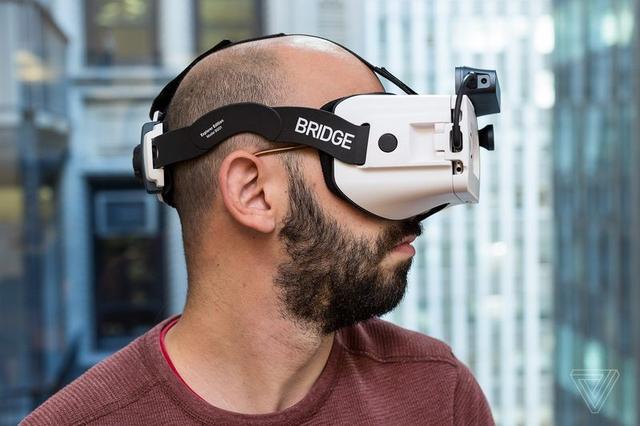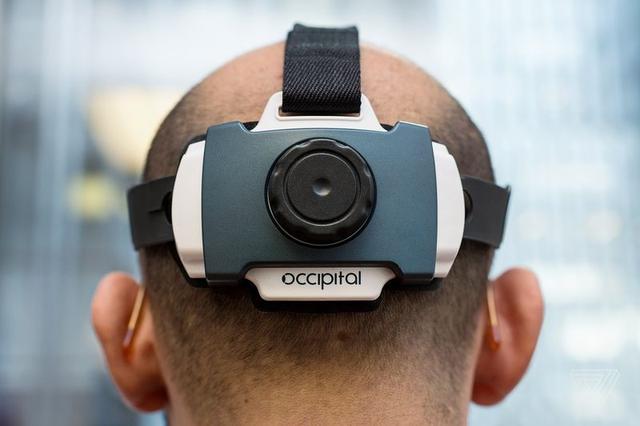Bridge integrates Occipital's Structure Sensor and supports Inside-Out location tracking, which greatly simplifies the mixed reality system. Its advantages include low prices and more openness

A few days ago I played a game with a robot and I threw a ball. A robot named Bridget walked in one of our conference rooms and picked it up. It also avoided the table, the box and the chair. After the game was over, I was caught in a momentary panic after I took off my head. Bridget was gone.
Perhaps the reader has already guessed: Yes, Bridget, who plays games with me, is a virtual robot that only exists in the iPhone that comes with the Occipital Mixed Reality Headset Bridge. Bridge maps the room around me and then creates the digital objects that Bridget can interact with - just as part of the actual room. In the 5-minute demo, Bridget interacted well with the digital room I was in. My brain was temporarily deceived: I think this digital robot is to some extent real.
In some respects, Bridge is quite similar to other mobile virtual reality heads: Insert an iPhone 6, 6S, or 7 and wear it over your head to enjoy a mobile virtual reality experience. It even comes with a Bluetooth remote that can handle some of the actions, similar to Google's Daydream virtual reality heads. Bridge is between Microsoft's HoloLens augmented reality glasses and Samsung Gear VR, but the price is closer to the latter. It will be sold (limited to several hundred units) from the next week at a price of $499. Occipital plans to sell a large number of Bridges in March next year for $399.
Bridge is unique in that it integrates Occipital's first product: Structure Sensor - a bookmark-sized camera and sensor band that realistically maps physical objects and environments. Structure Sensor brings the Inside-Out position tracking to the Bridge, allowing users to experience the feeling of walking around in real spaces without the need for an external camera or sensor. This means that in a virtual game, users can not only sit on one point, turn around, but also move around - there have been few mobile virtual reality heads to provide such an experience.
What Occipital is most proud of Bridge is mixed reality. Mixed reality refers to the experience of augmenting the immersion of virtual reality and virtual reality as a whole, rather than merely adding a headshot to the real world. It has changed the real world to some extent. Microsoft used the term "mixed reality" when talking about HoloLens glasses, but HoloLens mapped the images onto spectacle lenses. Occipital uses an iPhone camera (with a lens attachment to widen the viewing angle) to mix video and data from Structure Sensor to create a 3D stereoscopic view of the user's room.
All of this means that the Bridge hardware is not "slim," and the semi-rigid belt helps to disperse its weight and increase the degree of comfort. But it is not the cheapest hardware.
Before becoming a mainstream product, Bridge still needs further refinement. Although the location tracking function is quite accurate, a slight delay can make the user feel uncomfortable. After being divided into two eyes, the iPhone screen allocated by each eye is only 640 x 480 pixels in size. Although the Bridge outputs 60 frames per second, the iPhone only allows the companion application to read 30 frames per second. In fact, Occipital uses the sensor to predict the user's activity in two adjacent frames and then generates the corresponding view. As a result, although the picture is smoother, there is a clear sense of ambiguity.
Bridge allows users to walk around the room. Previously, to achieve the same function, users needed to deal with a powerful desktop computer, placed sensors or cameras around the room, the head display need to be connected to the PC through a wired method. Like many other companies interested in Inside-Out tracking, Occipital believes that in order to obtain this freedom, people can accept the deficiencies of this technology.

Jeff Powers, CEO of Occipital, said that he is not sure which applications are best suited for the head of the bridge. Augmented reality represents new issues and possibilities. Occipital hopes to help solve this problem. He said, "In games and virtual reality, users can control everything. Users "create" the entire world and decide what is happening in the world. In mixed reality, users are bound by the actual world. Therefore, the user creates objects, People must all interact with the real world. As a developer community, we do not yet know what issues need to be addressed."
"Summoning" Bridget's software is part of what Occipital calls the "Bridge Engine." Occipital plans to open this part of the software code to facilitate its collaboration with developers to create augmented reality experiences.
The demo provided by the Occipital to me is more than just a bot game with the robot, but this is the most interesting of the demo content. Other presentations include transforming one of our conference rooms into a spaceship.
By pressing a button on the Bluetooth remote control, I was able to place the furniture in the room precisely. Although there is a large amount of software to help customers choose the right new wallpaper or furniture, the effect of seeing the new table in the kitchen on the head and even moving the table in the space is still a little exciting. Bridge will be able to provide this experience, which is also an area that Occipital is familiar with - just one month ago, Occipital announced an application that uses Structure Sensor to create CAD-quality room scans.
Bowles said, "Many people in the interior decoration and construction industry have said that they want to show users virtual reality content, but users do not have the ability to handle powerful PCs."

It is not only Occipital's company that is interested in products between mobile and desktop virtual reality heads. Microsoft has been developing HoloLens glasses for some time; Google Tango has replaced the heads with tablets, but has been able to handle interior decoration and other work; Intel recently announced the Project Alloy "fused reality" virtual reality head; Oculus is developing support for location tracking, was The new head is called Santa Cruz. However, the development of Santa Cruz is still in the prototype stage. Intel never thought to formally sell Alloy on the market. Currently, the price of HoloLens is not generally high.
Compared with other platforms, Bridge's advantage is that it is cheap and more open, and it is one of the few mobile virtual reality head phones that supports the iPhone, except for paperboard or cheap plastic materials.
There are rumors that Apple is developing similar products, which means that Bridge will add another competitor.
Battery Online Monitoring System
Multifunctional Battery,Read Data And Information Battery,Safety Monitoring System Battery,Custom Monitoring System Battery
Wolong Electric Group Zhejiang Dengta Power Source Co.,Ltd , https://www.wldtbattery.com